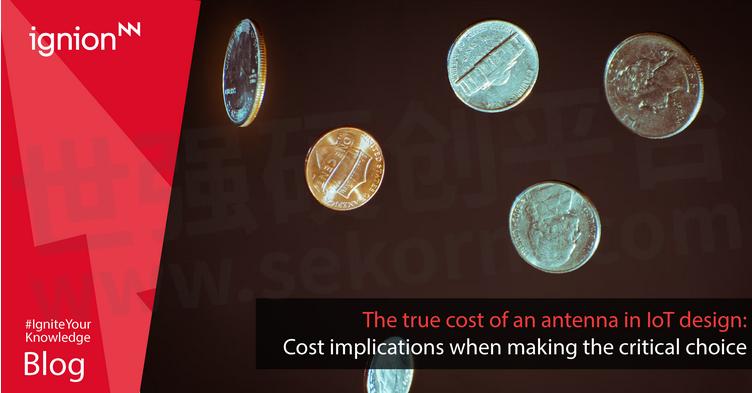The True Cost of an Antenna in IoT Design: Cost Implications when Making the Critical Choice


IoT products include many components, but there is one essential for them to be connected: the antenna. When it comes to choosing the antenna part for a new IoT device project, it is tempting to prioritize immediate cost savings by selecting the lowest cost option or the version that seems to have the fastest integration. However, a narrow focus, not considering the full picture, can lead to significant hidden costs and design inefficiencies that will add to the overall cost and timelines of the project and potentially its market viability.
*All the examples below depend on the specific frequency range, device size, and market requirements of the device.
The misleading appeal of PCB trace and patch antenna resulting in costly battery
Initially, opting for an antenna like a PCB trace seems economical as it is just printed on the circuit board. Yet, this approach can result in a final lower antenna efficiency and overlooks crucial aspects such as optimal coverage and battery life. This option can then result in using a battery with a larger capacity, which increases BOM costs. Read more on PCB trace compared with Virtual Antenna® here.
This BOM increase also happens in GNSS applications where a directive patch antenna is often used. If the patch is not oriented optimally the performance is significantly lowered. In battery-intensive applications like GPS asset tracking, where time to first fix (TTFF) can be a big battery drain, the result of using a patch antenna can necessitate a higher capacity (more expensive) battery.
Design and development delays with resonant chip antennas
Choosing subpar components can also lead to significant project delays. These delays not only stall the project but incur additional costs in terms of design and labor.
Some antenna components such as traditional resonant chip antennas, while seemingly adequate on datasheets can be suboptimal for the final stages of the design cycle when crucial RF performance certifications are sought for market entry. Integrating those antennas close to other components and device housing can compromise their efficiency and lead to frequency detuning. This detuning not only jeopardizes certification requirements but can demand a redesign including changing to another antenna component, incurring costly delays and additional non-recurring engineering (NRE) expenses. In contrast, Virtual Antenna® components, which don’t have a fixed native frequency, offer unmatched flexibility keeping the same antenna component and design with the ability to re-tune easily if needed.
Avoid FPC for consistency in design and manufacturing
Using a pick-and-place antenna in IoT design such as Virtual Antenna® components can streamline and ensure accurate performance as well as being less expensive than hand-placing antennas like Flexible Printed Circuit (FPC) antennas on the production line. Read our in-depth study in this whitepaper.
Markets like asset tracking or smart metering where a vendor may have a portfolio of several devices in different form factors could benefit financially from the economy of scale by using the same antenna part across various devices. With the same small high-quality Virtual Antenna® component across all devices in a portfolio and assembled using pick and place, the economies of scale are maximized.
Impact on device longevity and marketability
Any sub-optimal antenna in IoT design can drastically impact the lifespan of a device, failing to meet market expectations of reliability and range. Wireless reliability shortfall can result in a loss of consumer trust and potential revenue, while a shorter range can directly result in a narrower use case and marketability of the specific application.
The holistic approach to project costing
The key takeaway for IoT designers is to adopt a holistic view of project costs influenced by the antenna. Focusing solely on individual antenna component pricing can be misleading as long-term savings and efficiency gains of an optimal antenna solution are likely even more important to consider for any serious IoT project.
Instead, evaluating the impact of the antenna component when it comes to integration, design flexibility, and manufacturing in the overall project – including battery life, design consistency, and marketability – is crucial. Using a tool like Ignion’s Antenna Intelligence Cloud™ design tool can help to make these performance determinations at the beginning of the development process so a better understanding of the overall impact of the antenna on the project can be understood. A comprehensive approach ensures not only cost efficiency but can also enhance reliability and time to market for new products. Contact our team if you need any help in assessing options in your next IoT project.
- +1 Like
- Add to Favorites
Recommend
- NeuronicWorks Partners with Ignion to Accelerate IoT Device Designs with Virtual Antenna® Solution
- Virtual Antenna®, the clear winner over PCB trace in reducing hardware iterations
- Virtual Antenna® technology: Discover the secrets of thousands IoT product engineers
- AI & Machine Learning: Simplifying IoT Antenna Integration with Virtual Antenna® Technology
- Safer Journey Awaits: Igniting Road Safety with Virtual Antenna® Technology
- Revolutionary Virtual Antenna® Solution for Revolutionary Ski Boot Design
- Ignion Offers Reliable Antenna Performance for Cold Chain Asset Trackers even in -40℃
- Ignion Announces the Smallest Virtual Antenna™ at the Wi-Fi World Congress Which is with a size of only 3x2x0.8mm
This document is provided by Sekorm Platform for VIP exclusive service. The copyright is owned by Sekorm. Without authorization, any medias, websites or individual are not allowed to reprint. When authorizing the reprint, the link of www.sekorm.com must be indicated.






























































































































































































































































































































































































































































































































































































































































































































































































































































































